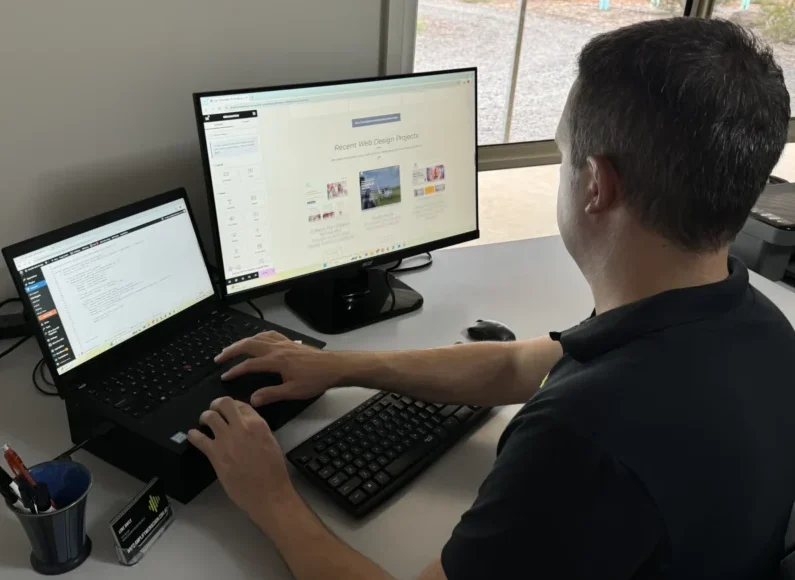If you run a reputable business and want your website to reflect your quality, then you must ensure you have decent search engine rankings. However, ranking on Google is not easy and there are several search engine optimization rules you must follow. Google’s most recent algorithm update is aimed at improving the quality of the search results. Needless to say, one must focus on quality and user experience at all times.
In this guide, we discuss some tips to help you boost your Google rankings and how Google ranking services in Adelaide can help you.
But first, how do you check your website’s rank on search engines?
How To Check Your Ranking on Search Engines?
The most reliable tools and websites where you can know your site’s rankings are Semrush, Advanced Rank Tracking, Pro Rank Checker, Ahrefs, Google Search Console, and Rank Watch. Most of these tools are low-cost and some, like Rank Watch, are also free. Cloud-based rank checkers like SEMrush and Pro Rank Checker are much simpler than other desktop-based rank checkers. If you want to do this yourself, then you can easily find a youtube video to navigate these tools.
However if you are protective of your time to spend on your business, then many SEO and Web Design agencies will offer a Free SEO Audit to tell you where the gaps on your website are. You don’t pay anything unless you want them to fix it, so there is no risk to you for knowing what could be done. A smart business owner who values their time should be asking who, not how, when solving problems.

10 Proven Tips to Increase Your Google Rankings
Tip 1: Best SEO Practices—It Is That Simple!
Many SEO companies won’t tell you this secret. The number one reason a lot of sites get the number one rank on Google, Bing, and Yahoo is because they are good at foundational SEO practices. It is really that simple. So what does being good entail?
- Follow the best SEO practices and guidelines that google themselves publish to the broader community. You can look these up yourself to see if you comply or engage SEO services in Adelaide to guide you in this aspect.
- Avoid all those “get links fast” schemes like the plague! Instead, sprinkle several high-quality, anchor-text-savvy links on the site. You will get google slapped if caught using SEO black hat strategies, so don’t risk it for the seeming quick win…. (they hardly work out anyway)
- Ensure Google-friendly and coherent on-site navigation so that you are providing your user a great experience online. Your content needs to be structured well and easily navigable.
- Ensure an up-to-date website with all of the functions and features operating. Having a site that is under-maintained will cost you in both user experience as well as page speed which both affect your rank.
- Understand your customers and match your content to their search intent. A customer who lands on your site, doesn’t find what they are looking for and then bounces off quickly identifies to google that you are not the right match for that keyword. Down in the ranks you go, so make sure if you target the keyword, you deliver on search intent.
Tip 2: Create High-Quality Content for Organic Traffic Growth
This has been the mantra since the dawn of SEO- content is king. Focus on creating original, killer content that other sites competing for similar keywords do not have. Rinse and repeat ad nauseum and you will eventually rank for those terms. Make sure to update old, outdated content from time to time.
Remember: Google does not owe you the number one spot. So keep refining your content, even if you have been number one for several years.
Quality content is sure to attract visitors and, more importantly, keep them on the site longer. This reduces your bounce rate, which is very important for Google ranking. Moreover, killer content will also attract backlinks, which enhances your SEO efforts.

Tip 3: Use Smart Keyword Research Strategies
Keyword research is essential for organic traffic growth. It helps you understand what your customers are searching for. It also helps you find all the keywords having high search volumes and low competition relevant to your niche/industry and your target audience.
In addition to understanding user intent, keyword research tells you if your content is a good fit for those searches. With proper keyword usage and placement, you can bring in plenty of qualified traffic, which, in turn, can improve your rankings. Moreover, it can help you add keywords your competitors aren’t using and get an edge over them.
Using basic keyword research, you might be tempted to go for the big volume, but this can be a trap. Finding those keywords which have lower volume, but are more relevant to your contents search intent can often give you a better conversion rate and this is what makes you the money. Get select and focus on conversions rather than just traffic volume because if that’s your problem, just go out and buy it.
Tip 4: Optimize On-Page SEO for Better SERP Rankings
Improving your on-page SEO is the fastest way to rank better in Google. To do this, use the following tips:
- Improve page loading speed—page loading speed has a direct bearing on your Google rankings. You can check this through googles Page Speed Insights or any other numbers of testers like Pingdom.
- Optimize the images used—many people fail to do this. But optimized images can also drive traffic to your site. Use the right image name in relation to the keywords. Always use alt text and don’t forget to provide additional image information, such as the image’s local location, in the schema markup. The best format we see for images is webp and allows higher quality images at a faster load speed.
- Be Specific about your meta descriptions. Meta descriptions with the target keywords help expand on the title tags and tell the web users why they should come to your site. We discuss this how to write compelling descriptions a little later in this guide.
Tip 5: Ensure Your Website is Mobile-Friendly
Prioritize mobile optimization as Google indexes mobile-based versions of the website instead of the desktop version. A mobile-friendly site easily adapts to different screen sizes and resolutions. It loads fast and has just a few basic links with a clear call to action. Using page builders like Elementor can allow you to quickly check if your page will look right in Responsive Mode which is a fancy way of saying “on a mobile device”.

Tip 6: Add Schema Markup for Google Visibility
Schema markup is a part of technical SEO that is concerned with the site’s structure or architecture. Your SERP optimization team can guide you in creating one. It is basically a code for Google to help understand your website better. It helps search engine crawlers navigate your site with ease. We find that with a flatter schema structure, that any future changes are less disruptive to your URL structure, so keep this in mind when optimising your schema.
Tip 7: Optimise for Google’s Featured Snippets
Featured snippets sit above the main organic search results and are called “position zero.” They provide more credibility to your site and also increase conversions. Good featured snippets directly answer the user’s query but also entice them to come to your site to learn more. You also want to optimise these sections in your content as this is likely what an AI bot will read when they reference your site. Optimising for both AI and Snippets is not in our direct control, but you can bet there are ways we can influence the outcome.
Tip 8: Use Internal Linking to Boost SEO Performance
Internal links link your content to other pages on your site. Internal linking helps establish a hierarchy of pages for your site. The more internal link value your pages have, the higher will be its value in Google. It is also an easy way to boost organic traffic growth.
The best internal linking comes from in-text references which appear as bold or coloured. An example would be if I was referencing The Best Value For Money Web Design in Adelaide. You can also provide links to other pages at the bottom with “related posts” or recommended readings, but try to get some in-text as best practice.

Tip 9: Improve Your URLs for Search Engine Ranking
Google always advises using simple URLs—URLs that contain the keywords related to a page. Use short, clean, and descriptive URLs that highlight the core topics through keywords. This will help search engines decide how important the URLs are to user queries.
Just make sure that when changing your URL’s (slowly) that you are also re-directing them. If google can’t find it (called a 404 error), then google assumes your site is broken and will lower your rank. Just let it know the new address and it will be happy again.
Tip 10: Write Compelling Meta Descriptions to Increase Clicks
Meta descriptions are short descriptions that appear under your page title. While Google does not use meta descriptions for ranking purposes, they can still bring traffic and clicks. This is because Google displays meta descriptions right under your page title in the search results.
Website optimization is a science and an art. It is not something that is quick and easy to do but with the above tips and the best Google ranking services Adelaide, you can avoid common pitfalls and build a long-term, successful website optimization program.
Get a free website analysis and ranking strategy.
Who will Improve Your Google Rank?
There are thousands of online videos showing you how to action any of these tips above. You can spend hours of your time researching and applying them, but why would you when you can easily engage someone else to do it for you. Smart business owners are those who can quickly identify a problem and then ask who, not how, it can be solved.
A good SEO web designer would have a copy of googles developer guidelines on their night stand, years of experience in building quality content and a track record of high ranking websites they have helped. If this sounds like the kind of person you need in your business, then go and have a chat with a few to find out which really know their stuff. Investing in an SEO expert should be a multiplier to your business revenue and if they aren’t, then you have found the wrong one.

How to Improve Google Ranking FAQ Section
How do Google ranking services in Adelaide help businesses?
Professional SEO services improve your website’s visibility by optimizing content, keywords, and technical aspects to rank higher in search results.
What are the best SEO practices for ranking higher?
Key practices include keyword research, on-page optimization, mobile-friendliness, fast loading speeds, and high-quality content.
How long does it take to see SEO results?
SEO is a long-term strategy, but most businesses notice improvements within 3 to 6 months with consistent optimization efforts.
What is SERP optimization and why does it matter?
SERP optimization ensures your site ranks well on search engine results pages (SERPs), improving organic traffic growth and business visibility.
How does keyword research impact my rankings?
Targeting high-volume, low-competition keywords helps attract the right audience and improve your website’s relevance for search queries.
Why is mobile-friendliness crucial for Google rankings?
Google prioritizes mobile-friendly sites since most users search on phones. A responsive design improves rankings and user experience.
What role do backlinks play in SEO?
High-quality backlinks from authoritative sites boost credibility and rankings, making your website more trustworthy in Google’s eyes.
Should I optimize for featured snippets?
Yes! Featured snippets position your site at “rank zero”, increasing visibility and click-through rates for relevant searches.
Can internal linking improve my website’s rankings?
Yes, internal links help distribute page authority, improve navigation, and keep visitors engaged longer, boosting rankings.
What’s the importance of a well-optimized URL?
Short, keyword-rich URLs help search engines understand page content and improve rankings while making links more user-friendly.

